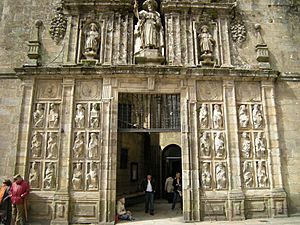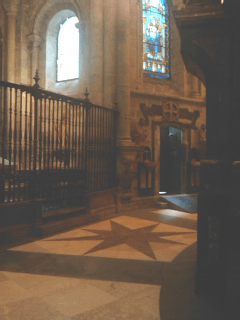Holy Door (Santiago de Compostela) facts for kids
The Holy Door (also called Puerta Santa in Spanish or Porta Santa in Galician) is a very special entrance at the back of the Santiago de Compostela Cathedral in Galicia, Spain. It's also known as the Door of Forgiveness. This door is usually kept closed and is only opened during a special time called a Jacobean Holy Year. When it's open, people like pilgrims can walk through it from the Plaza de la Quintana to enter the cathedral. It's believed that those who enter through this door during a Holy Year can receive special forgiveness for their sins.
Contents
What is the Holy Door?
The Holy Door is a unique entrance to the Santiago de Compostela Cathedral. It's not just any door; it has a long history and special meaning for many people. It's a symbol of new beginnings and forgiveness for pilgrims who have completed their journey to Santiago.
Its Old Name and Location
A long time ago, this door was known as the Porta de San Paio. It was named after Saint Pelagius, and there's a monastery across the plaza named after him too.
An old book called the Codex Calixtinus, written by Aymeric Picaud, described the cathedral as having many entrances. It mentioned the "Porta de San Paio" as one of the smaller ones.
The Holy Door you see today might not be in its original spot. The cathedral has been rebuilt and expanded over the centuries. An eight-pointed star on the floor inside the cathedral marks where the door might have been located before.
The Door of Forgiveness
The Holy Door is also known as the Door of Forgiveness. It's a very important part of the Jacobean Holy Year. A Jacobean Holy Year happens when Saint James' Day, which is July 25, falls on a Sunday. During these special years, the door is opened.
Pilgrims who enter the cathedral through this door can receive a "plenary indulgence." This is a special spiritual gift that means they can be forgiven for their sins. This tradition was started by Pope Alexander III in 1179.
Sculptures and Art
Above the outside of the door, there are sculptures of Saint James and his followers, Athanasius and Theodore. On the sides of the door, you can see twenty-four carved figures of prophets and apostles, including Saint James himself. Some of these figures were originally part of the cathedral's old stone choir, created by a famous sculptor known as Master Mateo.
Inside this outer door, there's a small courtyard. Beyond this courtyard is the true Holy Door.
Inside the Cathedral
The Holy Door opens into a circular walkway called the ambulatory inside the cathedral. This walkway is between two chapels: the Chapel of the Azucena (or Saint Peter) and the Chapel of the Savior. The construction of the cathedral actually began near the Chapel of the Savior in 1075.
Many believe the door was placed here for pilgrims because of its closeness to the ambulatory. Walking around the main altar and then going down to the tomb of the Apostle James marks the end of a pilgrim's long journey. Coming out from the tomb is seen as a symbol of new life and redemption.
Images for kids
See also
 In Spanish: Puerta Santa (Santiago de Compostela) para niños
In Spanish: Puerta Santa (Santiago de Compostela) para niños
- Stone choir of Master Mateo






